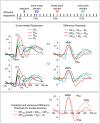Pre-attentive Mismatch Response and Involuntary Attention Switching to a Deviance in an Earlier-Than-Usual Auditory Stimulus: An ERP Study
- PMID: 30894807
- PMCID: PMC6414453
- DOI: 10.3389/fnhum.2019.00058
Pre-attentive Mismatch Response and Involuntary Attention Switching to a Deviance in an Earlier-Than-Usual Auditory Stimulus: An ERP Study
Abstract
An acoustic stimulus elicits an electroencephalographic response called auditory event-related potential (ERP). When some members of a stream of standard auditory stimuli are replaced randomly by a deviant stimulus and this stream is presented to a subject who ignores the stimuli, two different ERPs to deviant and standard stimuli are recorded. If the ERP to standard stimuli is subtracted from the ERP to deviant stimuli, the difference potential (DP) waveform typically exhibits a series of negative-positive-negative deflections called mismatch negativity (MMN), P3a, and reorienting negativity (RON), which are associated with pre-attentive change detection, involuntary attention switching, and reorienting of attention, respectively. The aim of the present study was to investigate how these pre-attentive processes are affected if the change occurs earlier than its usual timing implied by isochronous standard stimuli. In the MMN paradigm employed, 15% of the standards were randomly replaced by deviant stimuli which differed either in their pitch, their earlier onset time, or in both. Event-related responses to these three deviants [timely pitch change (RTP), earlier onset (REO), earlier pitch change (REP)] and to standards (RS) were recorded from 10 reading subjects. To maintain identical stimulation histories for the responses subtracted from each other, "deviant-standard" difference potentials (DP) for "timely" and "early" pitch deviances were derived as follows: DPTP = RTP - RS and DPEP = REP - REO. Interestingly, the MMN components of the DPs to timely and early pitch deviances had similar amplitudes, indicating that regularity of stimulus timing does not provide any benefit for the pre-attentive auditory change detection mechanism. However, different scalp current density (SCD) dynamics of the MMN/P3a complexes, elicited by timely and early pitch deviances, suggested that an auditory change in a stimulus occurring earlier-than-usual initiates a faster and more effective call-for-attention and causes stronger attention switching than a timely change. SCD results also indicated that the temporal, frontal, and parietal MMN components are simultaneously present rather than emerging sequentially in time, supporting the MMN models based on parallel deviance processing in the respective cortices. Similarity of the RONs to timely and early pitch deviances indicated that reorienting of attention is of the same strength in two cases.
Keywords: MMN; P3a; additivity; attention switching; inter-onset interval; pitch; regular stimulation.
Figures



References
-
- Baldeweg T. (2007). ERP repetition effects and mismatch negativity generation - a predictive coding perspective. J. Psychophysiol. 21, 204–213. 10.1027/0269-8803.21.34.204 - DOI
LinkOut - more resources
Full Text Sources
Miscellaneous

